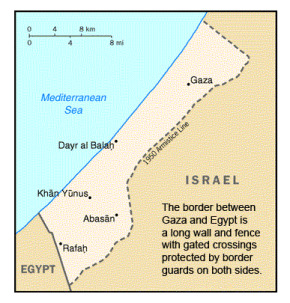Kites Soar Above Political Turmoil
 In one of the most dramatic recent examples of kites bridging geo-political divisions, comes a story from the border between Egyptand the Gaza strip in Palestinian territory.
In one of the most dramatic recent examples of kites bridging geo-political divisions, comes a story from the border between Egyptand the Gaza strip in Palestinian territory.
A news report by journalist Mohammed Omer, on the web site of the Inter Press Service International Association located in Rome, Italy, shows the power of kites to focus people on matters other than war and widely differing politics.
The story, entitled "Kites Rise Above Divisions" outlines how two young boys, one in Egypt and the other in Gaza, are able to reach above the dividing wall of the border and challenge one another in a test of skill and maneuverability. Even though the boys cannot see one another, as they look skyward they are able to recognize one another's kites by their construction and the approximate place on the ground from which they are flown.
Differing economic conditions point are still visible in the sky, Mohammed Omer notes, as the sails on kites from Gaza are made of newspaper and plastic bags while the kites of the Egyptian boys are made of traditional materials like colorful tissue paper and glue.
In the sky, the challenge is on - boys playing with one another in a test of wills and wits with a simple desire to enjoy the opportunities of a playful diversion and better a friendly adversary in a non-life threatening manner.
Mohammed Omer's story is not an isolated incident of kites soaring above the border with children engaging in skillful competition in the sky. The occurrence of kite flying contests between children from Gaza and Egypt happens on a regular basis.
In a dramatic blog posting on May 17, 2007 by Laila El-Haddad, a journalist mother who divides her time between Gaza and the United States, the contrasts between war and the peaceful activity of children flying kites on both sides of the Egypt-Gaza border are clearly outlined. Laila El-Haddad wrote about one such day of contrasts thus:
"After a terrifying 24 hours, we awoke this morning to sporadic gunfire, and ghostly streets."
"Though the gunfire had subsided, the gunmen were still patrolling the streets, each this time casually manning their own turf, masked and fully armed."
"We decided to avoid the town centre, and headed instead to film near the border area along Rafah’s edge. Young children blissfully flew handmade kites above the iron wall separating them from the Egyptian Rafah. Their "atbaq" flirted in the infinite sky above with kites flying their way from the Egyptian side. "We play a game with the Egyptian kids" they explained of their unseen counterparts. "We meet here, through our kites, and see who can catch the other's kites quicker by entangling. So far we're winning-we've got 14 Egyptian kites" he announced proudly."
"The children are small enough that they can wiggle their way through the cracks of the large iron gates along the wall-where once Merkava tanks made their unwelcome entrance to battered camps here. And so they can call out to their Egyptian friends, and learn their names and new kite flying techniques."
So it is with kites - their ability to reach into the sky, to ride on the wind, to challenge each flyer to master the currents and the capabilities of their own tethered aircraft will always rise above the seemingly intractible divisions of geopolitical differences.
It makes one wonder if we should have more adults flying kites rather than grinding on with the same old politics.
At least while flying a kite they would look up, see the sky and feel the pull of the wind. The sky knows no borders and the wind does not stop at border crossings. The friendly challenges of skill allows one to learn of your counterpart in terms other than politics and opens a window on the possibility of seeing your opponent as an individual, rather than a stereotypical member of group politics. Perhaps there are serious lessons to be learned through kites!
__________________
Notes:
- Kites flown by children in Egypt and Gaza tend to be of the generic, maneuverable single line 'fighter kite' type. Usually the sail is made of tissue paper with bamboo or similar shapable wooden spars for framing. Sometimes, newspaper or plastic bags are substituted for sail material if the more expensive tissue paper is not available.
- Kites made of more modern ripstop sailcloth material can sometimes be found in the sea coast tourist areas of Egypt.
- The Egyptian sea coast resorts are popular spots for tourists who engage in the expensive sport of kite boarding using modern kites by Naish and designs by Peter Lynn.
References (2)
-
 Source: Kites Rise Above Divisions
Source: Kites Rise Above Divisions -






Reader Comments